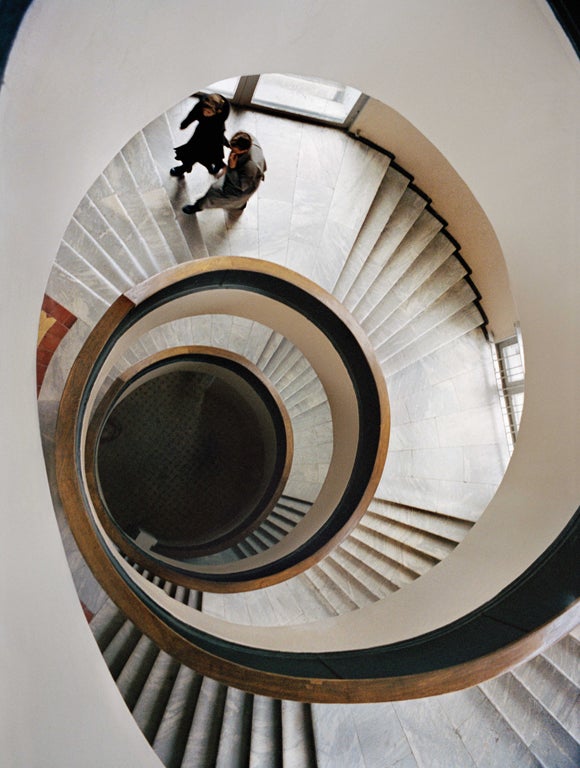Building the Revolution, Royal Academy, London
Early Soviet art and architecture were synonymous – so why does this show prise them apart?

Construction, Construction Art, Constructivism: it's quite a stretch.
The first sounds utilitarian, all hard hats and mud. The last two suggest wild-haired artists waving their arms and theorising. And yet, in Russia, for the two decades from 1915 to 1935, making art and making buildings were seen as subsets of each other, activities not so much running in parallel as jointly dedicated to building a revolution.
As with any grand construction, it began with a great tearing-down. In 1913, the Russian artist Kazimir Malevich painted Black Square, stripping art back to the basics of colour and geometry. It was a supreme position, and Malevich called his movement Suprematism. Pre-revolutionary Moscow was a place of factions, each bitterly fighting its corner. So when Aleksandr Rodchenko began making work in what looked like a Suprematist style, Malevich bitterly dubbed it "Construction Art".
As with Impressionism half a century before, the name stuck. When, in 1921, Rodchenko painted his three Pure Colour pictures in monochrome red, yellow and blue, his partner, Varvara Stepanova, pronounced the death of art. "From here," she said, grimly, "Constructivism will annihilate art in all its forms, ending its separate identity." Art, design and architecture would now be as one, the conjoined triplets of world revolution.
But what would that mean, exactly? A show called Building the Revolution at the Royal Academy answers that question from a Soviet point of view, although Constructivism survived longest outside the USSR. (Stalin suppressed it as elitist after 1932.) Many things had to be constructed in the aftermath of the October Revolution, and each seemed a metaphor for the other. There was the Marxist state; there was the heroic proletariat; and third, more prosaically, there was housing for that proletariat, and other structures – concert halls, radio masts, stadiums, shops, power stations. In this great revolutionary project, art needed to look relevant, of the people. And so Liubov Popova's Spatial Force Construction, also painted in 1921.
Taken literally, Spatial Force Construction looks like scaffolding, or the girders that held up the steel-framed buildings sprouting all over the new Soviet Union. To add to its workmanlike feel, Popova has made her work out of workaday things, the sort of materials you might find on any building site: paint, marble dust and plywood. Its surface is rough and unfinished, not at all like the slick varnishes of the ancien régime. For all that, though, Spatial Force Construction is a profoundly intellectual work, picking up on the deconstructive experiments of Cubism and taking them further, on into the realms of pure abstraction.
And so, as with Gustav Klutsis's Dynamic City, there is a degree of subterfuge going on. Klutsis's lovely painting looks like an architectural drawing or a graphic design – the study for a radial city, maybe, or a logo for Aeroflot. It sets out to look functional, as though, in the right hands, it might be made into something. And some of Klutsis's drawings were exactly that – studies for structures to be built, most famously the so-called "propaganda kiosks" of the early 1920s. The two kiosks that were actually erected were hugely popular in a way that his two-dimensional artworks never were. Tatlin's Monument to the Third International, aka Tatlin's Tower, is the most famous of these art/architecture hybrids, a scaled-up version of its original maquette currently standing, 10 or so metres high, in the Royal Academy's courtyard. Since the finished structure was meant to be 100 metres taller than the Eiffel Tower – it was never built – the effect is somewhat lost. In terms of scale, Anish Kapoor's monument to the 2012 Olympics, a distant nod to Tatlin, probably gives you a better idea.
All this is fascinating, as is the story told from the other side – namely, of architects who began working like artists. On the walls across from images by Klutsis, Popova et al, are photographs of Constructivist buildings – famous ones, such as the Melnikov House in Moscow, and lesser-known buildings such as those of the Checkist housing scheme. Always striking, often beautiful, these are curiously undersold in this show. While the name of the photographer who took the shots of the buildings is on the labels, you have to hunt for the names of the architects who built them: not very useful, really.
Also left out is the name of the man who saved all these Popovas and Klutsises – and a great deal more early Soviet art besides – from destruction: George Costakis, an ex-driver at the Greek embassy in Moscow, who spent the 1940s and 1950s truffling out hidden artworks and hanging them in his tiny flat. That his name doesn't appear next to each work in this show seems faintly thankless.
The main omission, though, is that Building the Revolution treats architecture and art as separate entities, when the point of Constructivism was not to.
Next Week:
Charles Darwent sees Leonardo at the National Gallery
Art Choice
Place your bets now on who will be this year's winner of the Turner Prize – Karla Black, Martin Boyce, Hilary Lloyd and George Shaw have work on display at the Baltic Gateshead (till 8 Jan). Tacita Dean has taken on the Tate's Turbine Hall; her 11-minute moving picture installation, FILM, will be lighting up the space until 11 March.
Join our commenting forum
Join thought-provoking conversations, follow other Independent readers and see their replies
Comments